-
收藏模板
- 模板信息
- 更新时间:2023-09-07
- 字数:约24108字
- 页数:约18页
- 格式:.doc
- 推荐版本:Office2016及以上版本
- 售价:5 金币
您可能喜欢的文档
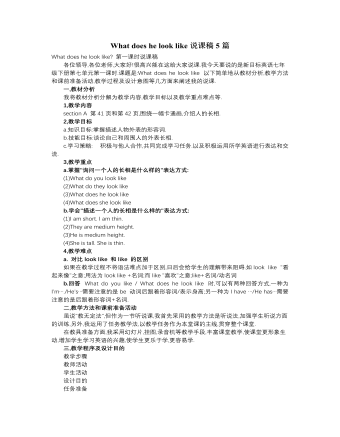
人教版新目标初中英语七年级下册What does he look like说课稿5篇
(四)、小结及布置作业(5’)对于本课的复习要点,我以课堂小结的形式展示给学生。(出示大屏幕)这样学生通过小结,对本课内容能够再次重申,体现出了本课的重点,使知识更加系统化、规范化。为了巩固本课内容,我给学生布置如下家庭作业。(出示大屏幕)课后描述一下你的父母,并写在作业本上四、板书设计(出示电脑屏幕)板书除了课题之外,我将本课的重点词汇always书于板书,并附例句,利于学生掌握该词的用法。并将本课的难点内容be+adj ,have+n.的用法书于板书,并附例句,利于学生突破难点。该板书简洁、清晰、明了,突出了本课的重难点。本课我以素质教育为目的,结合教材的重难点及英语学科的特点,采用任务型教学,从听、说、读、写、练等方面使学生得到了锻炼,在轻松、愉快的氛围中温故而知新,达到了培养学生用英语交际的目的。
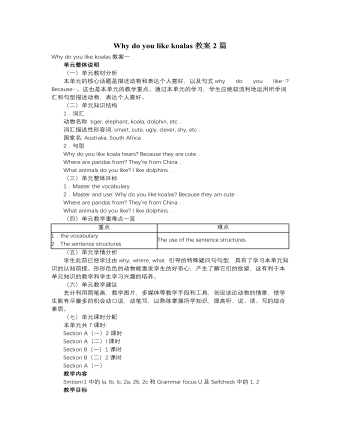
人教版新目标初中英语七年级下册Why do you like koalas教案2篇
单元整体说明(一)单元教材分析本单元的核心话题是描述动物和表达个人喜好,以及句式why do you like…? Because…。这也是本单元的教学重点。通过本单元的学习,学生应能较流利地运用所学词汇和句型描述动物,表达个人喜好。(二)单元知识结构1.词汇动物名称 tiger, elephant, koala, dolphin, etc.词汇描述性形容词: smart, cute, ugly, clever, shy, etc.国家名: Australia, South Africa2.句型Why do you like koala hears? Because they are cute.Where are pandas from? They're from China.What animals do you like? I like dolphins.(三)单元整体目标1.Master the vocabulary2.Master and use: Why do you like koalas? Because they am cute.Where are pandas from? They're from China.What animals do you like? I like dolphins.(四)单元教学重难点一览(五)单元学情分析学生此前已经学过由why, where, what 引导的特殊疑问句句型,具有了学习本单元知识的认知前提。形形色色的动物能激发学生的好奇心,产生了解它们的欲望,这有利于本单元知识的教学和学生学习兴趣的培养。
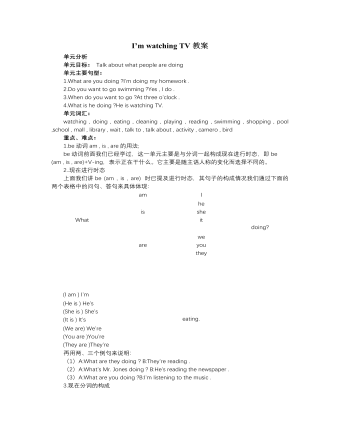
人教版新目标初中英语七年级下册I’m watching TV教案
单元分析单元目标: Talk about what people are doing 单元主要句型:1.What are you doing ?I’m doing my homework .2.Do you want to go swimming ?Yes , I do .3.When do you want to go ?At three o’clock .4.What is he doing ?He is watching TV. 单元词汇:watching , doing , eating , cleaning , playing , reading , swimming , shopping , pool ,school , mall , library , wait , talk to , talk about , activity , camero , bird 重点、难点:1.be动词am , is , are的用法;be动词前面我们已经学过,这一单元主要是与分词一起构成现在进行时态,即be (am , is , are)+V-ing,表示正在干什么。它主要是随主语人称的变化而选择不同的。2..现在进行时态上面我们讲be (am , is , are) 时已提及进行时态,其句子的构成情况我们通过下面的两个表格中的问句、答句来具体体现:3.现在分词的构成现在进行时态中be + V - ing 的构成中V-ing被称为现在分词,它的基本构成是动词原形+ing,但也有些特殊情况,下面分几类说明:(1)一般情况+ing如:read→reading,go→going,do→doing,look→looking,listen→listening,watch→watching.(2)以不发音的e结尾的词,去掉e,再加ing.如:write→writing,skate→skating,type→typing,wake→waking,make→making
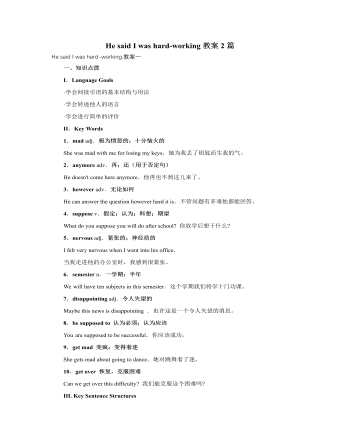
人教版新目标初中英语八年级下册He said I was hard-working教案2篇
This activity introduces some new vocabulary and provide oral practice using the target language.Task 1 . Ask four students to stand in front of the class, and the teacher asks them the following questions as a reporter.1.What are you going to do when you grow up?2.What are you going to do next week?3.What are going to do after school?The students will give different answers, then ask a good student to report what they said.I am going to e a doctor.What did she say?----------She said she was going to be a doctor.I am going to have a party on Friday night.What did he say?-------He said he was going to have a party on Friday night.I am going to do my homework.What did she say ?------ She said she was going to do her homework.I am going home after school.What did she say?-----She said she was going home after school.Say In this unit we are going to learn to use words like to report what someone said.Task 2. Read the instructions. Then ask a student to read the four questions. And write the words on the Bb. Explain what soap opera is.Task 3. Ask the students to Look at the pictures, point out the TV screens in the picture. Ask one girl to read what Marcia said.What did Marcia say? She said She said she was having a surprise party for Lana on Friday night. Repeat the other pictures in the same way.Activity3. Listen and number the pictures in activity 1a.
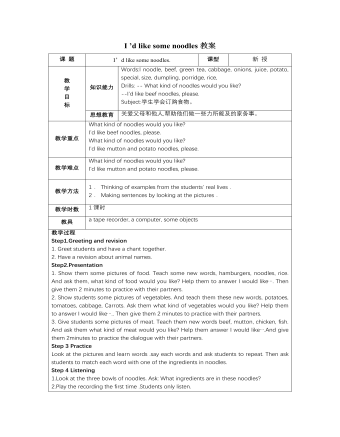
人教版新目标初中英语七年级下册I ’d like some noodles教案
教学过程Step 1: warming-up Sing a song---------“food and drink” Step 2: Revision1 Dictation2 Revise: What kind of noodles would you like?I’d like …What size bowl of noodles would you like?I’d like…Step 3: Presentation1 show pictures of food, ask students say the words.2 Students read the newspaper ad in 3a. Fill in blanks with words in the box. Then read the ad together, the teacher explains some difficult language points.3 Check the answers Step 4 PracticeAsk students to finish 3b in the same way according to 3a. Students read the short passage and fill in the blanks .At last, check the answers.Step 5 productionAsk students to write their own ad for dumplings, noodles, drinks, and other foods they know. Then ask students to read their partner’s ad. Then order food and drink from their partner.Step 6 Home workGroup work – make an ad about “food and drink”
- 查看更多相关Word文档
What does he look like教案3篇
What does he look like教案一
一、教材分析:
本单元的教学核心项目是“描述人的外貌”(Describe People),涉及到讨论人的身高、体重、发型、面部特征及其着装等语言项目。教材内容围绕着描述人的外貌特点展开,让学生学会谈论人的身高、体重、发型、面部特征及着装特点,以人的外貌特征为主线,兼顾交际功能的学习,以一种循序渐进的生活化的学习程序,引导学生学会用英语介绍自己或他人的外表特征。这些内容与学生的实际生活密切相关,易于引发学生运用简单的英语进行交际和交流,所以在学习活动中,学生能通过交换对不同人物的描述及看法,促进学生之间和师生之间的情感交流,增进情谊。
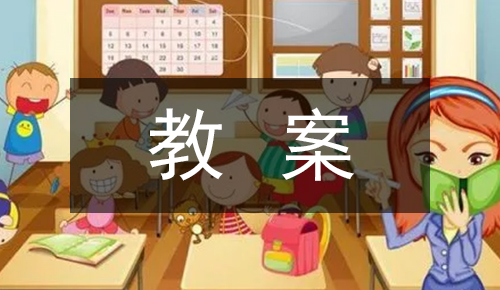
Section A从根据人的外貌特征找人,来呈现与此相关的形容词、短语 (Activity1a)到听力练习(Activity1b, 2a, 2b),让学生学会描述人的外貌(Activity3a),引出本单元的语法项目have动词、be动词和wear动词的用法,到句型操练(Activity1c,3,3b),语言目标层层递进,主要展示了重点句型:
What does he/she look like?
He/She is tall. He/She has curly hair.
What do you/they look like?
I’m thin. /They’re medium height.
最后还有一个猜人游戏:MysteryStudent(Activity4) 以游戏的方式来检测学生对本部分单词和句型的掌握情况。
Section B中的教学是在Section A的基础上展开的,不少知识点都是以旧带新,把所学的目标句型进行实际的综合运用。
先以Activity1a入手继续学习描述人的外貌特征的词和短语,再以Activity1b进行实际操练, Activity2a, 2b是一个综合的听力训练,用来展示学生的听力能力,并以听力内容为基础,通过Activity2c中描述自己的偶像的外貌的练习实现英语交际的功能。Activity3a通过比较Johnny Dean的前后照片培养学生的任务性阅读能力。 Activity3b是根据提供的图片进行填空的写作练习。Activity3c是一篇模仿写作,让学生写一篇描述他们家庭成员外貌的短文。
Self-check是课后自我表现检测,包括四个部分:
1.检测本单元所学词汇。
2.添加生词。
3.描述图片中人物的外貌。
4.最后在Just for Fun小幽默中轻松愉快地结束本单元。
二、教学目标:
(一)语言知识目标:
1.语法:①look like的问句及回答。
②wear的一般现在时用法。
③用于宽泛描述的形容词。
2.词汇:
名词:hair, height, build,captain, team, bit, joke, beard, glasses, look, singer, etc.
形容词:short, tall, medium,thin, heavy, blonde, brown, curly, straight, wise, popular, huge, teeny, etc.
动词:wear, stop, remember,say, etc.
3. 交际用语:What does he/she looklike?
He/She is tall. He/She has curly hair.
What do you/they look like?
I’m thin. /They’re medium height.
Do you know David? No./Yes.
(二)语言技能目标:
1.能熟练的用英语进行对人外表特点的描述,并根据描述画出人像。
2.能概括人物的外貌特征并根据人物特征推理出某一人物。
3.能替自己和别人进行新形象设计,能和合作伙伴互相交流,充分交换信息。
4.能掌握本单元出现的表示人外观的词组及句型,并能结合实际生活进行灵活运用,用这些词组及句型描述别人的外表,提高写作水平。
(三)情感态度目标:
1.通过描述自己、同学、亲人、偶像的外貌,简单地表达自己的观点或好恶,学会交换不同的看法,使学生在人际交往中学会尊重和理解别人。
2.教育学生要多发现别人的优点,学会赞美别人,友好地描述别人的形象。
3.学会赏识,懂得心灵美比外表美更重要。
4.能在小组活动中积极与他人合作,相互帮助,共同完成学习任务, 尽情享受学习的乐趣。
(四)文化意识目标:
了解不同人的外貌和同一人的不同外貌,了解在中西方文化中表达自己的观点时存在的差异,我们比较委婉,而西方人则比较直接些,对学生进行不同文化意识的渗透。同时让学生在给自己或别人画像时提高绘画水平和审美意识;让学生了解不同外貌作用的背景知识,实现跨学科交流的目的。
三、教学重难点:
通过学习语言材料,让学生获得运用所学的有关词汇、短语及句型,描述人的外貌特征,并能结合实际生活进行灵活运用的能力。
(一)重点:
1. 词汇(The vocabulary).
2. 句型:-What does he/she looklike?
-He/She is tall.
-What do you look like?
-I’m thin. I have shorthair.
-What do they look like?
-They’re medium height.They have long curly hair.
(二)难点:
1.has与is的正确使用。
2.Wear的正确使用。
3.描述人的外貌。
四、学情分析:
学生在七年级上册已经学过关于“What does he like?”这一特殊疑问句式,具有了学习本单元知识的认知前提,能自然地与本单元话题进行衔接。谈论人的外表形象是人们日常生活中遇到的话题。故学生喜于用英语表达此类知识。
五、教学方法和学习策略:
(一)教学方法:
1.情景交际法:本单元话题源自生活,立足这一点,充分利用学生已有的知识和经验,创设生活化的真实情境,引导学生在运用中学习语言,然后在学习新的语言知识后创造性地运用语言(为用而学,在用中学,学了能用)。
2.任务型语言教学法:设计多种任务活动,提供给学生合作交流的空间和时间,促使学生为完成任务和同学进行合作,为完成任务进行探究学习。
(二)学习策略
1.自主学习:要求学生采用自主学习的方式,能根据需要进行有目的预习,使其对教师的教学内容起补充作用。
2.合作学习:在与同学合作完成任务的活动中形成合作学习和探究学习的学习方式,引导学生积极思考,善于抓住英语交流的机会。在活动中相互探讨、相互交流、相互合作,从而获得知识、技能和情感体验,发展他们的能力。
3.通过猜同学、猜明星、调查汇报,创设情景和有意义的任务活动,激发学生的学习热情,培养他们的概括和推理能力,发挥他们自己的主观能动性,把被动的学习变为主动学习,让学生巩固所学语言知识。
4.能利用网络上的学习资源查找信息,用所学内容进行真实的交际,积极参与课外英语学习。
六、主题语表:
hair: short, long,
curly, straight, bald,others: wear glasses,height: tall, short,
blonde, brown etc wear white shoes…medium height
↖ ↑ ↗
physical appearance
↙↘
face: beard, mustache,figure: thin, heavy,
eye (big blue..) etc a medium build
七、课时分配设计:
本单元分为四课时:
Period 1: section A-1a, 1b, 1c.
Period 2: section A-2a, 2b, 3,3a, 3b, 4.
Period 3: section B-1a, 1b, 2a, 2b, 2c, 3a, 3b.
Period 4: Section B - 3c, 4, Self-check.
八、教学过程设计:
Period One
(一)教学目标:
I.知识目标:
1.单词: hair, curly, straight,height, tall, medium, thin, heavy, build.
2.句型:-- What does he/shelook like?
--He/She is tall and haslong hair.
--What do you look like?
--I’m thin.
II.能力目标:
1.学完本课,学会描述人物外貌。
2.能积极思维,运用所学单词,短语及句型,结合实际生活进行灵活运用。
III.情感目标:
让学生学会友好地描述别人的形象。
(二)教学重点:
掌握本课新单词、句型和怎样描述一个人的外貌。
(三)教学难点:
掌握运用动词have和be描述人物外貌的方法。
(四)教学设计:
Step I. Warming-up:
Play a game “Polly says…”.Tell the Ss the rules:If Polly says touch your eyes/ears/ nose/mouth/shoulder/legs/arms.You should do it. If it doesn’t say that, you can’t do it. If you are wrong,you have to sit down. The person who does it correctly is the winner.
Step II. Presentation:
1.Say“Great!”to the winner and lethim/her be in front of the class. Then talk about the winner with the wholeclass:Do you think he/she is very great? Do youlike him/her? What is he/she like? What does he/she look like? Is he/she tall/short?What does he/she wear?
2.Show the photos of some famous people to introduce hairstyle,height and build. Teach the new words and the new sentence pattern.
3.Go over the spelling and the pronunciation of the new words withthe Ss.
Step III. Pair work:
At first the teacher gives the Ss an example with a picture ofJackie Chen.
A: What does he look like?
B: He has short hair. He is medium build. He is a little short.
Then ask Ss practice like this.
Step IV. Play a guessing game:
At first the teacher gives the Ss an example. Then ask Ss to guesstheir classmates’ names with the descriptions as quickly as possible.
Step V. Activity1a—1b:
1. Let the Ss look at the picture at page 41 and match the peoplein the picture with the words. And check the answers together
2. Let the Ss listen Activity 1b carefully, fill in the blanks inthe picture at page 41 and find Amy’s friend. We can listen twice.The first time, just listen.The second time,listen and fill in the blanks.And say something aboutAmy’s friend’s look.( Hes really tall.And he has curly hair.)
Step VI. Draw and describe:
Ask Ss to draw a picture of “What do you look like when you are 20years old? ” and descry
Step. VII. Homework:
1. Remember all of the new words.
2. Do the Ex. in the Ex. Book.
3.Write a short passage about what your favorite teachers looklike.
教学反思:
Period Two
(一)教学目标:
I.知识目标:
1.单词:always, captain,popular, team, good-looking, a little bit, joke, never, stop,brown, blonde, beard, glasses.
2.句型:同第一课时。Do you know David?No./Yes.
II.能力目标:
1.提高听读能力。
2.能抓住人物的主要特征来描述人物的外貌。
3.能概括人物的外貌特征并根据人物特征推理出人物。
III.情感目标:
教育学生要多发现别人的优点,学会赞美别人。
(二)教学重点:
掌握本课新单词和句型和熟练掌握描述人物外貌的方法。
(三)教学难点:
熟练掌握描述人物外貌的方法并成功地根据人物特征推理出某一人物。
(四)教学设计:
Step I. Revision:
1. Revise the description words of the people’s look.
2. Talk about the hairstyles of themselves, and tell the Ss tochoose a new look for themselves to revise how to describe hairstyles.
3. Talk about the hairstyles of the people in the picture byasking:“What does he/she look like?”
4.Say something more about other people.
Step II. Activity2a,2b,3:
1.Let the Ss listen Activity 2a carefully, circle“is”or“has”.
2.Listen the conversations again and fill in the blanks. Then saysomething about the students’ look.(eg. David is tall andheavy.And he has curly hair.)
3.Let the Ss find the difference between “is”or“has” and payattention to how to use “is”or“has”.
4.Tell the Ss: Lily has a new friend in Class Five. Do you want toknow her? Let’s help Lily describe her new friend.
5.Check the answers.
6. Practice the conversation.
Step III. Presentation:
1.Talk about Lily’s new friend’s look with the picture, and presentthe new words: good-looking.
2. Talk about some more photos of some famous stars to teach thenew words: popular, blonde, tell jokes, brown, captain, a little bit, beard,glasses.
Step IV. Activity3a:
1.Let the Ss describe the four people in the picture.
2.Let the Ss read the descriptions of the four people, and matchthem with the pictures on Page43.
3.Check the answers.
4.Show the language points in Activity3a.
5. Let the Ss read after the tape.
Step V. Activity3b:
1.Let the Ss do pairwork. Student A writes the names in the boxnext to the people in the picture on Page 43. Student B asks questions to findthe people. They can ask and answer like this:
B: What does Paul look like?
A: He’s tall and he has brown hair.
2.Let the student B report like this:
Paul is tall and he has brown hair.
…is …l and he has … hair.
Step VI. Survey
Make a survey: What does your bestfriend look like? What does he/she like doing?
Fill in the blanks:
name friend’s name is has wears likes
Jim Peter tall short hair a black coat reading
2. Report like this: Jim’s best friend is Tom. He is tall. He hasshort hair. He often wears a black coat. He likes reading.…
Step VII.. Game:
Show two photos of two famous stars, and let the Ss guess who itis by describing about the height/build/hair/eyes/wearing/job. Step. VIII.Homework:
1. Finish Section B 1a-1b.
2. Do the Ex. in the Ex. Book.
3.Tell the Ss: Do you want to have a new look? What do you looklike? Write a short passage about your new look.
教学反思:
Period Three
(一)教学目标:
I.知识目标:
1.单词:look, remember, nobody,singer, teeny, huge, dreamer, wise, pop singer, now, say.
2.句型:复习前面句型。
II.能力目标:
1.提高听读能力。
2.能概括人物的外貌特征并区别人物和推理出某一人物。
3.能替自己和别人进行新形象设计,能和合作伙伴互相交流,充分交换信息。
III.情感态度目标:
1.通过描述同学、自己、偶像的外貌,简单地表达自己的观点或好恶,学会交换不同的看法,使学生在人际交往中学会尊重和理解别人。
2.培养正确的审美观。
(二)教学重点:
掌握本课新单词和句型和熟练掌握描述人物外貌的方法并能灵活运用于生活中。
(三)教学难点:
掌握描述人物外貌的方法,能尽可能完整地描述人的外貌。
Step I. Check the homework:
1.Section B 1a,1b.
2. Let the Ss show their new looks and describe themselves.
3. Let other students talk about the changes of their classmates.
Step II. Revision:
1.Tell the Ss: I think your new looks are very great. And why doyou think people want to have a new look? (Be different, beautiful,popular…)But not all the new looks look beautiful. Do you think so? The personin the picture also has some new looks. Would you please help him?
2.Show the Ss some pictures of George Bush. Let them describe thepictures, and choose the best one.
3.Tell the Ss: The one fits you best is the best.
Step III. Presentation:
1.Ask: Who do you think often has a new look? (Actors, actresses,singers,…)They’re all famous persons. They want to be different, cool,beautiful and popular.
2. Show the two pictures of Ge You to present the followinglanguage items:
He has black short straight hair. His eyes are a little bit small.He has a mustache. He wears a T-shirt.
Now, he has a new look. He doesn’t have hair. He is bald. Hedoesn’t have mustache. He wears a suit. He isn’t good-looking. But he is veryfunny. He plays well. He is a pop actor.
Step IV. Practice:
Show the Ss an old photo of Ren Xianqi. Let the Ss guess who heis. Then show them another photo. Let the Ss say something about the twophotos.
Step V. Activity2a, Activity2b:
1.Say: Now, Maria and Danny are also talking about two famouspeople. Look at Page44 and find out their names. Make sure the Ss can read thenames correctly.
2.Let the Ss describe the two people in the picture.
3.Listen to the conversation, write down the job each person does.
4. Listen again and write down what each person looks like.
5.Check the answers.
Johnny Dean Tina Brown
Job rocker singer
movie actor
Looks like tall, thin, long curly hair, glasses
medium height, long blonde hair
Step VI.Activity3a:
1.Help the students describe the two pictures of Johnny Dean. Andfind the difference between the two pictures of Johnny Dean.
2.Ask a student to read the article about Johnny Dean.
3.Read the article with the whole class, and fill in the blanks inthe chart.
4.Go through the article and give necessary explanation.
Step VII. 3b:
1.Look at the pictures of Gloria Green. Then fill in the blanks inthe article.
2.Ask one student to read for the class to follow.
Step. VIII. Homework:
1.Remember all the new words in Selfcheck1 by heart.
2.Do the Ex. in the Ex. Book.
3.Decribe some of your members in your mind.
教学反思:
Period Four
(一)教学目标:
I.知识目标:
1.单词句型:复习整个单元。
II.能力目标:
1.能熟练的用英语进行对人外表特点的描述,并根据描述画出人像。
2.能掌握本单元出现的表示人外观的词组及句型,并能结合实际生活进行灵活运用这些词组及句型描述别人的外表,提高写作水平。
(二)教学重点:
描述人物外貌特征和写作。
(三)教学难点:
听文画图,看图写文。
Step I. Dictation:
Dictate the words in Self check 1.
Step II. Revision:
1.Show the old photos of Heinan and Wang Fei. Let the Ss guess whothey are and ask the Ss to choose one to describe to their partner.
2.Show another two photos of the two stars and ask the Ss to talkabout the differences between each two photos.
3.Let some Ss say something about the two famous stars.
Step III. Game:
Show some parts of the photos of Xu Ruoxuan and Jet Chow slowly.Let the Ss play a guessing game. They should only ask about their looks likethis: Is he/she tall? Does he/she have big eyes?
Step IV. Activity3c:
1.Let the Ss make a survey with their partners about their familymembers:
family member
height build hair eyes glasses(√/)
father
tall
medium height
short straight
small
2.Let the Ss report like this: Jim’s father is tall and heavy. Hehas short straight hair. He has small eyes. He doesn’t wear glasses.
Step V. Activity4:
1.Have the Ss get into groups of four. Tell the students in eachgroup to give themselves numbers from 1 to 4.
2.Give one of the students a photo of a person and describe it.Ask the other three students in each group to listen to the description anddraw the person. Have them listen to the description several times.
3.Let the Ss show their pictures to the class. Find out the bestdrawing and the winner.
Step VI.Selfcheck3:
Introduce Old Henry and his neighbors to the Ss and tell them thatthey are performing in a play. Let the Ss write down the description on Page46.
Step VII. Homework:
1.Revise this unit.
2.Do the Ex. in the Ex. Book.
3.Write something about Old Henry and his neighbors.
教学反思:
What does he looklike?教案二
Task 1: 班级同学性格分类
Step one: 以小组为单位,作自我介绍,小组内做好纪律。
Step two: 小组间成员互换,综合全班情况。
Name | Serious | Funny | Smart | Friendly | Shy | Unfriendly |
|
|
|
|
|
|
|
|
|
|
|
|
|
|
|
|
|
|
|
|
|
|
|
|
|
|
|
|
|
|
|
|
|
|
|
Step three: 每组选一名同学,进行统计,统计每一项人数,得出全班同学性格中最大的共同特点,并找出个性差异明显的,对性格进行分类。
Introvert(内向) |
|
Extrovert(外向) |
|
讨论:哪种性格好,哪种性格不好,为什么?
所需用到的句子:
What is he like?
He is ...
What is she like?
She is ...
5 students are introvert.
20 students are extrovert.
I like to be friendly, because I can makefriends.
I do not like to be shy, because it is notgood.
Task 2: 猜猜他是谁?
Step one: 学生们以小组的形式围坐在一起。每一小组选出一个人作为被描述的对象,本组所有人(包括他本人)用英文说一句话来描述他的特征。
Step two: 其他组同学猜他是谁,看看哪组同学猜出的最多。
所需用到的句子:
What is he or she like?
He is ...
She is ...
Task 3: 职位申请
Step one: 课前准备,制作一张帖有本人照片的申请表,带到课堂上。
Step two: 把同学们分成小组,把申请表打乱顺序发给每个小组,假设每一组成员都是某种职业的招聘者。他们从申请表中选出想要的人,并说明为什么。转载请注明出处!本文地址:
https://www.lfppt.com/worddetails_59814152.html最新课件教案文档
-

精选高中生期末评语
1、该生学习态度端正 ,能够积极配合老师 ,善于调动课堂气氛。 能够积极完成老师布置的任务。学习劲头足,听课又专注 ,做事更认 真 ,你是同学们学习的榜样。但是,成绩只代表昨天,并不能说明你 明天就一定也很优秀。所以,每个人都应该把成绩当作自己腾飞的起 点。2、 你不爱说话 ,但勤奋好学,诚实可爱;你做事踏实、认真、为 人忠厚 ,是一个品行端正、有上进心、有良好的道德修养的好学生。在学习上,积极、主动,能按时完成老师布置的作业,经过努力 ,各 科成绩都有明显进步,你有较强的思维能力和学习领悟力,学习也有 计划性,但在老师看来,你的潜力还没有完全发挥出来,学习上还要有持久的恒心和顽强的毅力。
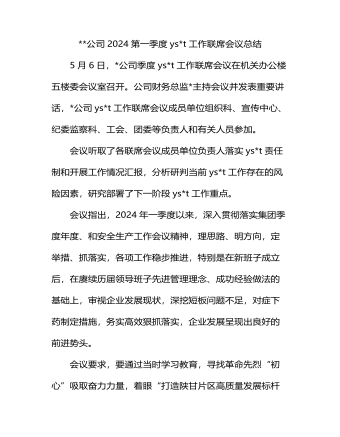
公司2024第一季度意识形态工作联席会议总结
一是要把好正确导向。严格落实主体责任,逐条逐项细化任务,层层传导压力。要抓实思想引领,把理论学习贯穿始终,全身心投入主题教育当中;把理论学习、调查研究、推动发展、检视整改等有机融合、一体推进;坚持学思用贯通、知信行统一,努力在以学铸魂、以学增智、以学正风、以学促干方面取得实实在在的成效。更加深刻领会到******主义思想的科学体系、核心要义、实践要求,进一步坚定了理想信念,锤炼了政治品格,增强了工作本领,要自觉运用的创新理论研究新情况、解决新问题,为西北矿业高质量发展作出贡献。二是要加强应急处事能力。认真组织开展好各类理论宣讲和文化活动,发挥好基层ys*t阵地作用,加强分析预警和应对处置能力,提高发现力、研判力、处置力,起到稳定和引导作用。要坚决唱响主旋律,为“打造陕甘片区高质量发展标杆矿井”、建设“七个一流”能源集团和“精优智特”新淄矿营造良好的舆论氛围。三是加强舆情的搜集及应对。加强职工群众热点问题的舆论引导,做好舆情的收集、分析和研判,把握时、度、效,重视网上和网下舆情应对。
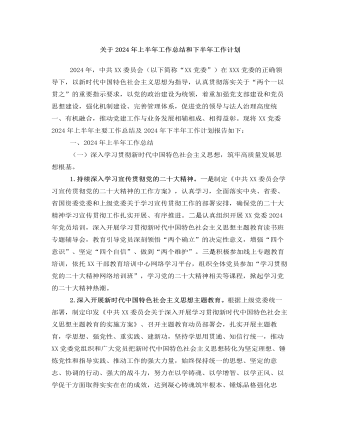
关于2024年上半年工作总结和下半年工作计划
二是深耕意识形态。加强意识形态、网络舆论阵地建设和管理,把握重大时间节点,科学分析研判意识形态领域情况,旗帜鲜明反对和抵制各种错误观点,有效防范处置风险隐患。积极响应和高效落实上级党委的决策部署,确保执行不偏向、不变通、不走样。(二)全面深化党的组织建设,锻造坚强有力的基层党组织。一是提高基层党组织建设力量。压实党建责任,从政治高度检视分析党建工作短板弱项,有针对性提出改进工作的思路和办法。持续优化党建考核评价体系。二是纵深推进基层党建,打造坚强战斗堡垒。创新实施党建工作模式,继续打造党建品牌,抓实“五强五化”党组织创建,广泛开展党员教育学习活动,以实际行动推动党建工作和经营发展目标同向、部署同步、工作同力。三是加强高素质专业化党员队伍管理。配齐配强支部党务工作者,把党务工作岗位作为培养锻炼干部的重要平台。
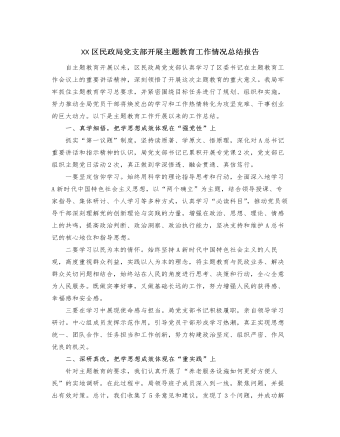
XX区民政局党支部开展主题教育工作情况总结报告
二要专注于解决问题。根据市委促进经济转型的总要求,聚焦“四个经济”和“双中心”的建设,深入了解基层科技工作、学术交流、组织建设等方面的实际情况,全面了解群众的真实需求,解决相关问题,并针对科技工作中存在的问题,采取实际措施,推动问题的实际解决。三要专注于急难愁盼问题。优化“民声热线”,推动解决一系列基层民生问题,努力将“民声热线”打造成主题教育的关键工具和展示平台。目前,“民声热线”已回应了群众的8个政策问题,并成功解决其中7个问题,真正使人民群众感受到了实质性的变化和效果。接下来,我局将继续深入学习主题教育的精神,借鉴其他单位的优秀经验和方法,以更高的要求、更严格的纪律、更实际的措施和更好的成果,不断深化主题教育的实施,展现新的风貌和活力。
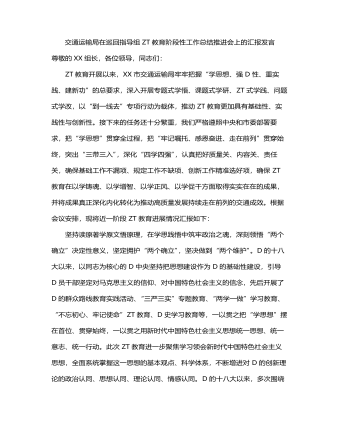
交通运输局在巡回指导组主题教育阶段性工作总结推进会上的汇报发言
今年3月,市政府出台《关于加快打造更具特色的“水运XX”的意见》,提出到2025年,“苏南运河全线达到准二级,实现2000吨级舶全天候畅行”。作为“水运XX”建设首战,谏壁闸一线闸扩容工程开工在即,但项目开工前还有许多实际问题亟需解决。结合“到一线去”专项行动,我们深入到谏壁闸一线,详细了解工程前期进展,实地察看谏壁闸周边环境和舶通航情况,不断完善施工设计方案。牢牢把握高质量发展这个首要任务,在学思践悟中开创建功之业,坚定扛起“走在前、挑大梁、多做贡献”的交通责任,奋力推动交通运输高质量发展持续走在前列。以学促干建新功,关键在推动高质量发展持续走在前列。新时代中国特色社会主义思想着重强调立足新发展阶段、贯彻新发展理念、构建新发展格局,推动高质量发展,提出了新发展阶段我国经济高质量发展要坚持的主线、重大战略目标、工作总基调和方法论等,深刻体现了这一思想的重要实践价值。
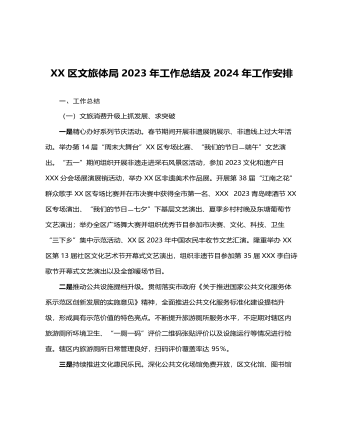
XX区文旅体局2023年工作总结 及2024年工作安排
三、2024年工作计划一是完善基层公共文化服务管理标准化模式,持续在公共文化服务精准化上探索创新,围绕群众需求,不断调整公共文化服务内容和形式,提升群众满意度。推进乡镇(街道)“114861”工程和农村文化“121616”工程,加大已开展活动的上传力度,确保年度目标任务按时保质保量完成。服务“双减”政策,持续做好校外培训机构审批工作,结合我区工作实际和文旅资源优势,进一步丰富我市义务教育阶段学生“双减”后的课外文化生活,推动“双减”政策走深走实。二是结合文旅产业融合发展示范区,全力推进全域旅游示范区创建,严格按照《国家全域旅游示范区验收标准》要求,极推动旅游产品全域布局、旅游要素全域配置、旅游设施全域优化、旅游产业全域覆盖。
今日更新Word
-

精选高中生期末评语
1、该生学习态度端正 ,能够积极配合老师 ,善于调动课堂气氛。 能够积极完成老师布置的任务。学习劲头足,听课又专注 ,做事更认 真 ,你是同学们学习的榜样。但是,成绩只代表昨天,并不能说明你 明天就一定也很优秀。所以,每个人都应该把成绩当作自己腾飞的起 点。2、 你不爱说话 ,但勤奋好学,诚实可爱;你做事踏实、认真、为 人忠厚 ,是一个品行端正、有上进心、有良好的道德修养的好学生。在学习上,积极、主动,能按时完成老师布置的作业,经过努力 ,各 科成绩都有明显进步,你有较强的思维能力和学习领悟力,学习也有 计划性,但在老师看来,你的潜力还没有完全发挥出来,学习上还要有持久的恒心和顽强的毅力。
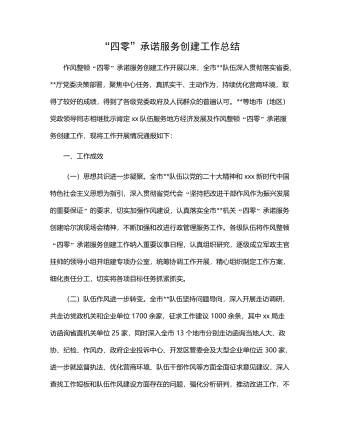
“四零”承诺服务创建工作总结
(二)坚持问题导向,持续改进工作。要继续在提高工作效率和服务质量上下功夫,积极学习借鉴其他部门及xx关于“四零”承诺服务创建工作的先进经验,同时主动查找并着力解决困扰企业和群众办事创业的难点问题。要进一步探索创新,继续优化工作流程,精简审批程序,缩短办事路径,压缩办理时限,深化政务公开,努力为企业当好“保姆”,为群众提供便利,不断适应新时代人民群众对政务服务的新需求。(三)深化内外宣传,树立良好形象。要深入挖掘并及时总结作风整顿“四零”承诺服务创建工作中形成的典型经验做法,进一步强化内部宣传与工作交流,推动全市创建工作质效整体提升。要面向社会和公众庄严承诺并积极践诺,主动接受监督,同时要依托电台、电视台、报纸及微信、微博等各类媒体大力宣传xx队伍作风整顿“四零”承诺服务创建工作成果,不断扩大社会知情面和群众知晓率。
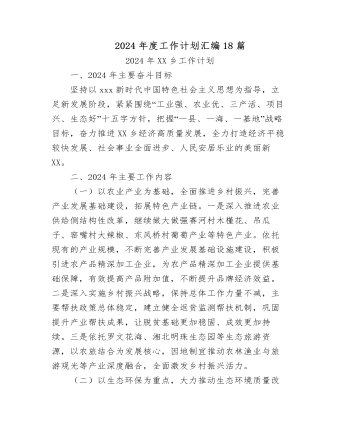
2024年度工作计划汇编(18篇)
1.市政基础设施项目5项,总建设里程2.13km,投资概算2.28亿元。其中,烔炀大道(涉铁)工程施工单位已进场,项目部基本建成,正在办理临时用地、用电及用水等相关工作;中铁佰和佰乐(巢湖)二期10KV外线工程已签订施工合同;黄麓镇健康路、纬四路新建工程均已完成清单初稿编制,亟需黄麓镇完成图审工作和健康路新建工程的前期证件办理;公安学院配套道路项目在黄麓镇完成围墙建设后即可进场施工。2.公益性建设项目6项,总建筑面积15.62万㎡,投资概算10.41亿元。其中,居巢区职业教育中心新建工程、巢湖市世纪新都小学扩建工程已完成施工、监理招标挂网,2月上旬完成全部招标工作;合肥职业技术学院大维修三期已完成招标工作,近期签订施工合同后组织进场施工;半汤疗养院净化和医用气体工程已完成招标工作;半汤疗养院智能化工程因投诉暂时中止;巢湖市中医院(中西医结合医院)新建工程正在按照既定计划推进,预计4月中下旬挂网招标。

驻村工作队2024年第一季度工作总结汇编(4篇)
三是做大做强海产品自主品牌。工作队于xx年指导成立的冬松村海产品合作社,通过与消费帮扶平台合作,在工作队各派出单位、社会团体、个人支持下,已获得逾xx万元销售额。2022年底工作队推动合作社海产品加工点扩建的工作方案已获批,待资金下拨后将正式启动扩建工作。四是积极助企纾困,带动群众增收致富。工作队利用去年建立的xx镇产业发展工作群,收集本地企业在产品销售、技术、人力、资金、运营、用地等方面的需求,并加大xx支持乡村振兴力度,xx助理赴各村委开展多场xx政策支持乡村振兴宣讲活动,本季度有x万元助农贷款获批,xx万贷款正在审批中。在壮大既有产业的同时,完善联农带农机制,一方面鼓励企业雇用本地农户就业,另一方面计划与本地农户签订长期收购合同,让农民种得放心、种得安心,带动当地群众共同致富。

主题教育总结常用提纲大全
第一,主题教育是一次思想作风的深刻洗礼,初心传统进一步得到回归。第二,主题教育是一次沉疴积弊的集中清扫,突出问题进一步得到整治。第三,主题教育是一次强化为民服务的生动实践,赤子之情进一步得到提振。第四,主题教育是一次激发创业担当的有利契机,发展层次进一步得到提升。2.第一,必须提领思想、武装思想。第二,必须聚焦问题、由表及里。第三,必须领导带头、以上率下。第四,必须务实求实、认真较真。3.一是抬高政治站位,坚持大事大抓。二是坚持思想领先,狠抓学习教育。三是突出问题导向,深入整改纠治。四是坚持领导带头,发挥表率作用。4.一是立足“早”字抓筹划。二是着眼“活”字抓学习。三是围绕“统”字抓协调。5.一是形势所需。二是任务所系。三是职责所在。四是制度所定。6.一要提升认识。二要积极作为。三要密切协作。
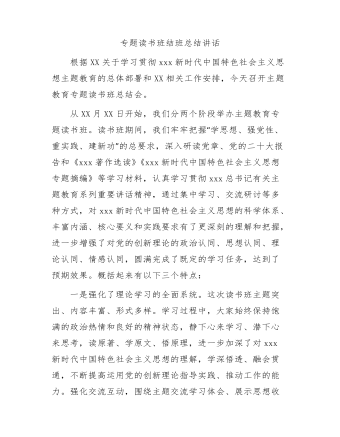
主题教育专题读书班结班总结讲话
第二,要把调查研究贯穿始终,实干担当促进发展。开展好“察实情、出实招”“破难题、促发展”“办实事、解民忧”专项行动,以强化理论学习指导发展实践,以深化调查研究推动解决发展难题。领导班子成员要每人牵头XX个课题开展调查研究,XX月底前召开调研成果交流会,集思广益研究对策措施。各部门、各单位要制定调研计划,通过座谈访谈、问卷调查、统计分析等方式开展调查研究,解决工作实际问题,帮助基层单位和客户解决实际困难。第三,要把检视问题贯穿始终,廉洁奉公树立新风。认真落实公司主题教育整改整治工作方案要求,坚持边学习、边对照、边检视、边整改,对标对表xxx新时代中国特色社会主义思想,深入查摆不足,系统梳理调查研究发现的问题、推动发展遇到的问题、群众反映强烈的问题,结合巡视巡察、审计和内外部监督检查发现的问题,形成问题清单。

















